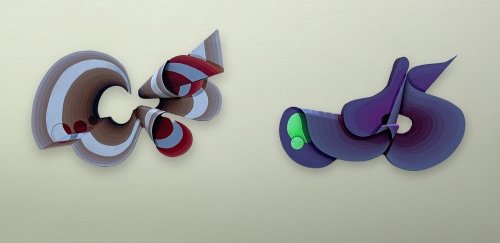Portfolio Submission Guidelines
- There must be a portfolio of work for each course submitted for Art Program credit.
- Portfolios must be sorted by course.
- For each course, the number of examples submitted must reflect the quality and scope of work completed.
- Submitting too few examples may not provide enough evidence for the review committee.
- For each course, please limit the number of examples to a maximum of 20 for each portfolio.
- Digital portfolios and/or original artworks in a protective portfolio or container may be submitted.
Digital Portfolios
While physical portfolios with original art may be submitted, the digital format is most often used. Students with portfolios on cloud storage services (e.g. Google Drive) or websites may paste the links into the Transfer Portfolio Form. To avoid delays in your review decision, please follow the guidelines.
- Digital portfolios must be sorted by course.
- Please limit the number of image files to a maximum of 20 for each portfolio.
- Up to three different views of a 3-D project or project with multiple pages will be considered a single submission.
- The dimension for each image file should be no larger than 1000 pixels in height or width at 72 ppi.
- File size of each image should be no larger than 3 MB (Megabytes)
- File formats may be JPEG, PNG, or GIF. Video files should be MPEG4 or MOV format.
- Do not upload PDF files or excessively large files to cloud storage services (e.g. Google Drive).
- Portfolios created with Adobe Publish Online or Share For Review should be added as links on the Transfer Form.
Portfolios for Digital Media Courses
Students have the option of including any combination of images, video links, etc. on video hosting sites, such as Vimeo or YouTube. Static images should be in jpeg format. Video files or animation should be gif, mpeg4 or mov format. Please note the committee will not view video samples that exceed five minutes, so please edit your materials accordingly. Any other projects, such as applications or video games, should be compatible with Mac computers.
Portfolios for Studio Concentration Courses
Students may submit portfolios for ceramics, digital media, graphic design, painting, photography, printmaking, metalsmithing and jewelry design and sculpture. If a 3-4 credit studio course is not listed on the RIC TES or is designated as “99999 Free Elective” or “XFER 999 Free Elective,” students may still submit a portfolio for these classes and may receive program or elective credit. Examples of such classes include Color, Watercolor, Digital Art, Web Design, etc.
Portfolios for Photography
A portion of photography portfolios may be submitted in digital form; however, a selection of prints and proof sheets must also be included for ART 217: Introduction to Photography credit. (This course includes darkroom techniques)
Portfolios for Foundations Courses
Because the majority of transfer portfolios are for foundations courses, the following foundation courses offered at RIC will describe the specific criteria used in the review:
ART 101: Drawing I: Basic Drawing
The portfolio must demonstrate adequate abilities in the use of art elements and compositional strategies. Competent use of line, shape, value, proportion, organization of space, perspective and composition are essential considerations.
ART 104: Design I: Two-Dimensional Design
The portfolio must demonstrate adequate abilities in the use of art elements, including color theory and principles of organization. Competent use of visual structure, color, organization of space, problem-solving skills and quality of execution are essential considerations.
ART 105: Drawing II: Figure Drawing
he portfolio must demonstrate the use of the basic visual language to effectively design coherent and unified compositions based on the analysis and interpretation of visual perception, as well as skills in two-point perspective, foreshortening, shape, line, tone, composition, expression, media and anatomy. Competence in the use of structural and gestural lines, linear variation and tone are essential considerations.
ART 107: Foundations in Digital Media
In order to receive credit for Foundations in Digital Media, students must prove proficiency in basic pixel-based, vector-based, and time-based art. Portfolios must demonstrate basic abilities of organizing visual elements, composition, form and space, light and color and combine fundamental artistic knowledge in the digital form.
ART 114: Design II: Three-Dimensional Design
Portfolios must demonstrate adequate skills in visual structuring, basic problem-solving, process and media as it relates to the development of form and basic materials construction and manipulation skills. Competence in visual structuring strategies, sequencing, dimensional evolution, understanding and use of both planar and volumetric form, sophistication of concepts and craft are essential considerations.
ART 204: Synthesis/Three-Dimensional Emphasis
If submitting a portfolio to request program credit for ART 204: Synthesis/Three-Dimensional Emphasis, the portfolio must adequately demonstrate abilities more advanced than the first five foundations courses. Typically, students at this level of study are simultaneously enrolled in a level-one studio concentration course. A series of works that demonstrate a consistent personal investigation and a high level of technical proficiency must be present in the portfolio for a positive review.
ART 205: Synthesis/Two-Dimensional Emphasis
If submitting a portfolio to request program credit for ART 205: Synthesis/Two-Dimensional Emphasis, the portfolio must adequately demonstrate abilities more advanced than the first five foundations courses. Typically, students at this level of study are simultaneously enrolled in a level-one studio concentration course. A series of works that demonstrate a consistent personal investigation and a high level of technical proficiency must be present in the portfolio for a positive review.



